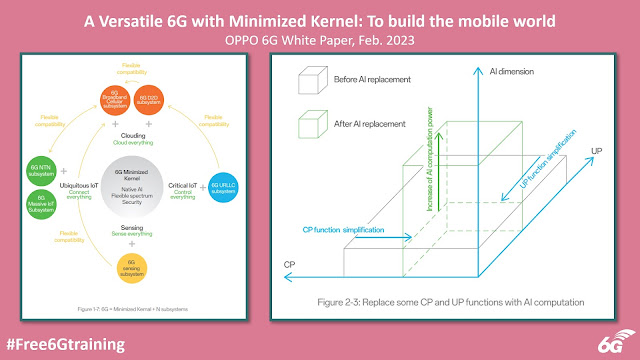In our earlier post on "OPPO's 6G AI-Cube Intelligent Networking" we looked at how OPPO sees AI as the main differentiator for 6G which is why they introduced the AI Function Plane as a new dimension in 6G networks, running perpendicular to the traditional CP and UP planes to form an Intelligent Cube (AI-Cube). The whitepaper expanded this concept.
At MWC 2023, OPPO released a new 6G whitepaper, "A Versatile 6G with Minimized Kernel: To Build the Mobile World". The whitepaper proposes a new innovative ‘versatile 6G system with minimized kernel’ that aims to provide a more actionable solution for the next generation of mobile communication systems.
In an operating system (OS), a kernel is a fundamental component that acts as a bridge between the hardware and software layers. It is the core part of an operating system that manages the system's resources and provides essential services to enable the execution of applications. The kernel is responsible for various critical tasks, including but not limited to: process management, memory management, device management, file system management, system security, inter-process communication, etc.
The kernel operates in privileged mode, which grants it direct access to the hardware and allows it to perform critical operations that ordinary applications cannot. It serves as the foundation for the entire operating system, providing essential services and managing system resources to enable the execution of user programs and ensure the overall stability and security of the system. Wikipedia has a good summary.
Quoting from OPPO press release:
OPPO’s vision for 5G and 6G technology is to enable a truly mobile world. Steps towards this mobile future have already been made with 5G, which has evolved the role of communications technology from simple “connectivity” to the Internet of Things with a multitude of different devices. Based on this vision, a key direction for the development of 6G technology will be the greater integration of AI technology into communications networks. Such networks will no longer be confined to just transmitting data: instead, they will be able to rapidly transmit and deploy a vast set of AI models. Among these models, a large number of AI agents will be trained to become intermediaries to help people manage and control all manner of things. As certain AI agents cannot exist in the physical world, this form of ‘management’ can only be realized in the virtual world. In these cases, digital twins representing physical objects will be constructed in the virtual world, enabling control of the physical world through these virtual proxies. In this way, 6G will help to further advance the Internet of Things from a series of connected devices to a series of converged devices operating as part of intelligent networks.
Based on this vision, the white paper proposes the role of 6G as one which facilitates communication between the virtual world and the real world, realizing the interconnection and convergence of these two worlds to form the basis of the metaverse and the foundations for a truly mobile world.
To realize this vision, OPPO has proposed a new design idea for 6G called “the versatile 6G system with minimized kernel”. The concept consists of a “minimized 6G kernel” that provides shared capabilities such as native AI, spectrum sharing and security, and multiple “6G subsystems”. The design comprises a suite of technologies covering disciplines such as the integration of AI and 6G, security architecture, spectrum sharing, mobile broadband and D2D protocols, improved low latency and reliability, the integration of communication and sensing, zero-power technology, and more. Compared to the “scalable parameter sets + network slices” approach to network resource allocation used in 5G, this new solution allows 6G to be better optimized for vertical applications.
Within this system, the minimized 6G kernel provides the underlying capabilities shared by all subsystems within the network. The AI capabilities integrated through 6G will help the network to efficiently deploy the different capabilities of the 6G subsystems to the corresponding vertical applications. By intelligently realizing on-demand networking and resource allocation, the networks will be able to meet the ever-changing connectivity needs of different applications. At the same time, the new security structure will require the establishment of a multi-party trust model and endogenous security with intelligent security to protect a wide range of service data. Finally, flexible spectrum management and sharing will use blockchain technology to simplify spectrum allocation and management and improve spectrum utilization efficiency.
To deal with the diverse demands of different applications on the networks, separate optimizations will be made for four different capabilities, including Clouding, Critical IoT, Ubiquitous IoT, and Sensing, with one or more subsystems designed for each of these capabilities. These subsystems can be combined and switched on-demand through AI to serve different industries and applications.
For example, the 6G non-terrestrial network subsystem can break constraints imposed by time, cost, or geography by introducing additional satellite communication capabilities into the 6G system. This can support broader network coverage to better serve applications that place higher requirements on coverage over high data rates. Another example is the 6G sensing subsystem, which integrates both communication and sensing technologies. Partial localization capabilities are already possible with 5G, however, with 6G, ubiquitous sensing functionality will be realized through the introduction of new sensing capabilities. By capturing every detail in the physical world, 6G networks will be able to support the construction of digital twins in the virtual world.
You can download the paper from here.
The video below from MWC 2023 shows OPPO's cutting-edge tech concepts:
Related Posts:
- Free 6G Training: 6G News and Announcements from MWC 2023
- Free 6G Training: OPPO's 6G AI-Cube Intelligent Networking



Comments
Post a Comment